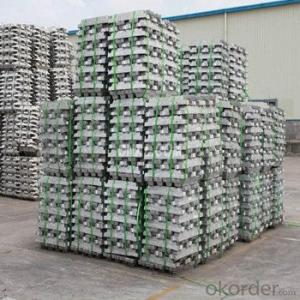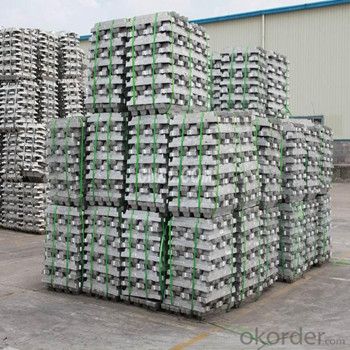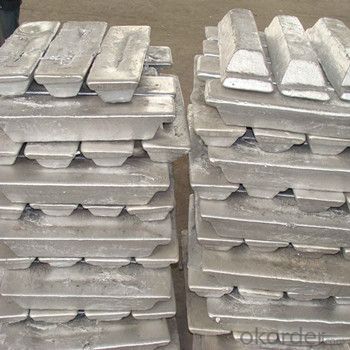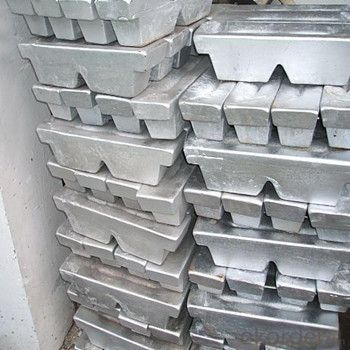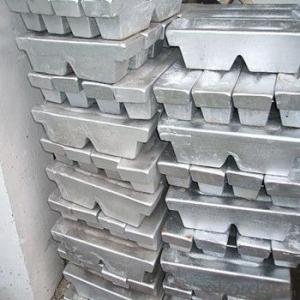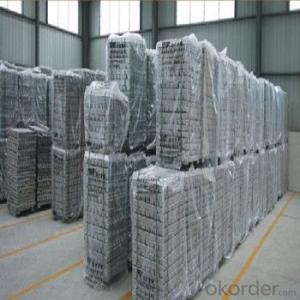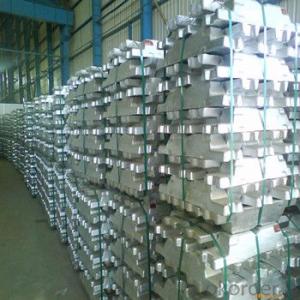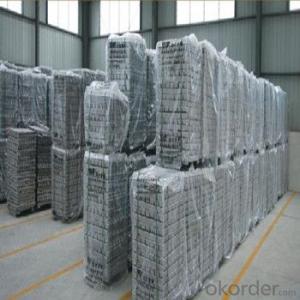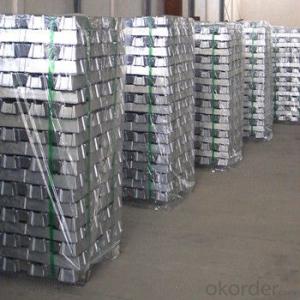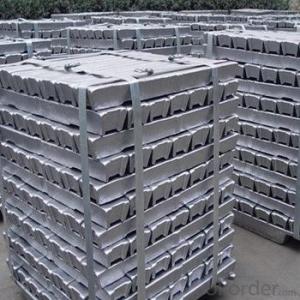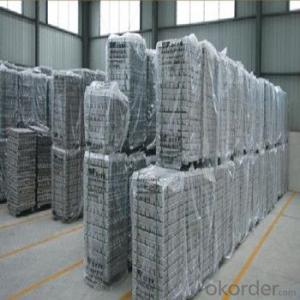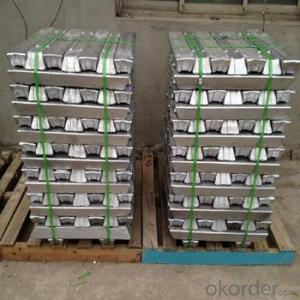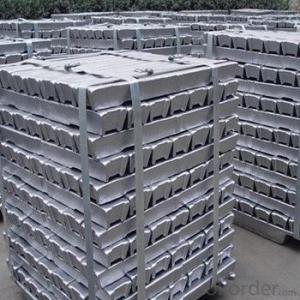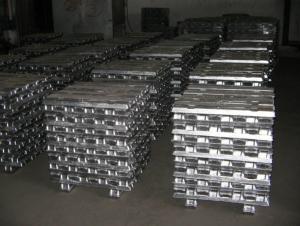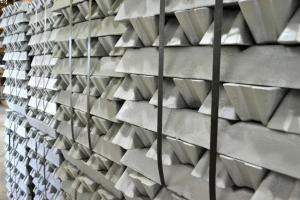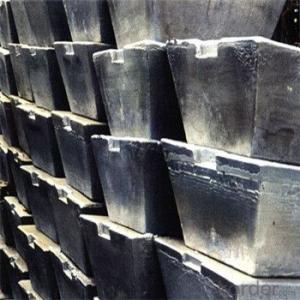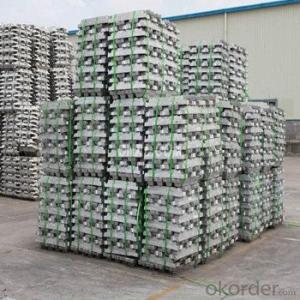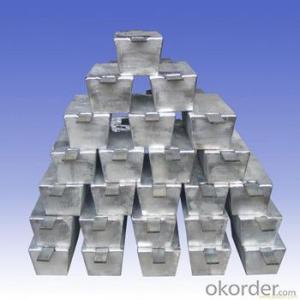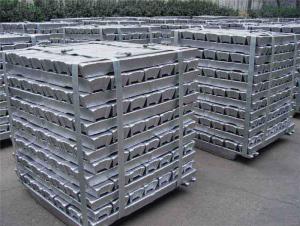Aluminum Pig/Ingot With Different Grade For Choice
- Loading Port:
- China main port
- Payment Terms:
- TT OR LC
- Min Order Qty:
- 1000 m.t.
- Supply Capability:
- 100000 m.t./month
OKorder Service Pledge
OKorder Financial Service
You Might Also Like
Pure Aluminum Pig/Ingot Used for Industry
1.Structure of Aluminum Pig/Ingot
A material that has been cast into a shape in order to be transported and processed easier than in an unprocessed form. An ingot is typically rectangular in shape, which allows it to be stacked. Ingots are most commonly associated with metals, with ingots of gold held in the vaults of banks and brokerages being popular images.
Aluminum Ingot is with the AL as the main chemical composition.Aluminum Ingot is used for industry,such as automobile,pinning and weaving,electron broadly and so on. Aluminum Ingot has the following advantages: easy control and operation, fast melting.
2.Main Features of the Aluminum Pig/Ingot
•High Purity
•Easy control and operation
•High strength
•Fast melting
•Competitive price
•Best Service
3.Aluminum Pig/Ingot Images
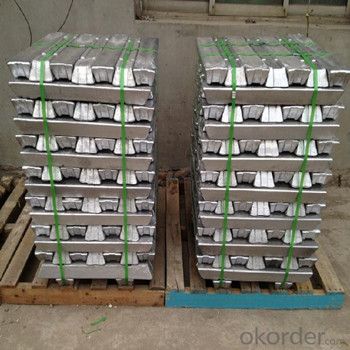
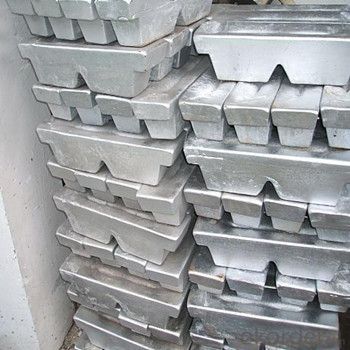
4.Aluminum Pig/Ingot Specification
Grade | Chemical Composition % | |||||||||
Al≥ | impurities ≤ | |||||||||
Si | Fe | Cu | Ga | Mg | Zn | Mn | others | Sum | ||
Al99.9 | 99.90 | 0.50 | 0.07 | 0.005 | 0.02 | 0.01 | 0.025 | - | 0.010 | 0.10 |
Al99.85 | 99.85 | 0.80 | 0.12 | 0.005 | 0.03 | 0.02 | 0.030 | - | 0.015 | 0.15 |
Al99.7 | 99.70 | 0.10 | 0.20 | 0.010 | 0.03 | 0.02 | 0.030 | - | 0.030 | 0.30 |
Al99.6 | 99.60 | 0.16 | 0.25 | 0.010 | 0.03 | 0.03 | 0.030 | - | 0.030 | 0.40 |
Al99.5 | 99.50 | 0.22 | 0.30 | 0.020 | 0.03 | 0.05 | 0.050 | - | 0.030 | 0.50 |
Al99.00 | 99.00 | 0.42 | 0.50 | 0.020 | 0.03 | 0.05 | 0.050 | - | 0.050 | 1.00 |
5.FAQ of Aluminum Pig/Ingot
We have organized several common questions for our clients,may help you sincerely:
①How about your company?
A big and famous and professional manufacturer & supplier of Aluminum Pig/Ingot, is one of the one of the large-scale professional investment Aluminum Pig/Ingot production bases in China.It have focuses on producing the Aluminum Pig/Ingot production for many years and gotten rich experience.Annually lagrge amount of Aluminum Pig/Ingot production are exported to markets in Europe,America and Japan. The quality and service have also gotten OEM service is available according to customer’s requirements.
②How to guarantee the quality of the products?
We have established the international advanced quality management system,every link from raw material to final product we have strict quality test;We resolutely put an end to unqualified products flowing into the market. At the same time, we will provide necessary follow-up service assurance.
③How long can we receive the product after purchase?
In the purchase of product within three working days, We will arrange the factory delivery as soon as possible. The pecific time of receiving is related to the state and position of customers.Commonly 7 to 10 working days can be served.
- Q: What is the tensile strength of aluminum ingots?
- The tensile strength of aluminum ingots can vary depending on the specific alloy and manufacturing process used. However, on average, aluminum ingots have a tensile strength ranging from 70 to 700 megapascals (MPa). It is important to note that the tensile strength can be influenced by factors such as the purity of the aluminum, the presence of impurities, and the heat treatment process. Additionally, different aluminum alloys have varying tensile strengths, so it is essential to specify the specific alloy when determining the tensile strength of aluminum ingots.
- Q: What's the difference between aluminium ingot A380 and ADC12?
- ADC12 material has better flowability than A380, and silicon content is higher than A380. But the mechanical properties of the two materials can be universal. Two types of materials can be mixed, it is recommended to communicate with customers first
- Q: What are the benefits of using aluminum ingots in the construction of lightweight structures?
- The benefits of using aluminum ingots in the construction of lightweight structures include their excellent strength-to-weight ratio, corrosion resistance, and recyclability. Aluminum is a lightweight metal that offers high strength, allowing for the creation of sturdy structures with reduced weight. Its corrosion resistance ensures durability and longevity, especially in outdoor applications. Additionally, aluminum is highly recyclable, making it an environmentally friendly choice.
- Q: What are the different extrusion processes for aluminum ingots?
- Aluminum ingots can undergo various extrusion processes, each with distinct characteristics and applications. Some commonly employed methods for aluminum extrusion are: 1. The most widely used process for aluminum ingots is direct extrusion. It involves heating the ingot and pushing it through a die using a ram or hydraulic press. The material flows in the same direction as the ram, resulting in a continuous profile with a consistent cross-section. 2. Indirect extrusion, on the other hand, utilizes a stationary die and a hollow ram to force the ingot through the die. The material flows in the opposite direction of the ram, resulting in a profile with superior surface finish and improved mechanical properties. 3. Impact extrusion is employed to create hollow shapes like tubes or containers. It entails striking a punch against the ingot, causing the metal to flow around the punch and form the desired shape. Impact extrusion is ideal for high-volume production of small parts. 4. Unlike the aforementioned processes that involve heating, cold extrusion is conducted at room temperature. The ingot is placed in a die and compressed using a hydraulic press or mechanical force. Cold extrusion is particularly useful for producing intricate shapes with precise tolerances and excellent surface finish. 5. Hydrostatic extrusion necessitates placing the ingot in a sealed chamber filled with a liquid, typically oil or water. Pressure is exerted on the liquid, which then applies even pressure on the ingot. This method is often employed for extruding alloys with low ductility or complex shapes. Each extrusion process presents its own advantages and limitations, and the choice depends on factors such as the desired product shape, material properties, production volume, and cost considerations.
- Q: Can aluminum ingots be used in 3D printing?
- Yes, aluminum ingots can be used in 3D printing. Aluminum is a commonly used material in additive manufacturing due to its lightweight, high strength, and excellent thermal conductivity. However, instead of directly using aluminum ingots, a process called powder bed fusion, specifically selective laser melting (SLM) or electron beam melting (EBM), is utilized. In this process, fine aluminum powder is spread in thin layers and selectively melted by a laser or electron beam, layer by layer, to create the desired 3D object. This allows for the production of complex geometries and precise parts with high strength and accuracy.
- Q: What are the quality standards for aluminum ingots?
- Various organizations and regulatory bodies establish quality standards to ensure the production of high-quality and consistent aluminum products. These standards play a vital role in defining the quality requirements for aluminum ingots. Here are some of the commonly observed quality standards: 1. Chemical Composition: The mechanical properties and suitability of aluminum ingots for specific applications greatly depend on their chemical composition. Quality standards specify acceptable ranges for elements like aluminum, iron, silicon, copper, magnesium, and other impurities. 2. Purity: To ensure minimal impurities and contaminants, aluminum ingots must meet specific purity requirements. Standards usually set limits for impurities such as oxides, alkali metals, and heavy metals to maintain the desired level of purity. 3. Physical Properties: Quality standards also cover various physical properties, including density, tensile strength, elongation, hardness, and thermal conductivity. These properties determine the performance of the ingots in different applications and enable manufacturers to produce consistent and reliable aluminum products. 4. Grain Structure: The mechanical strength and formability of aluminum ingots are influenced by their grain structure. Quality standards define acceptable grain size and uniformity to ensure consistent properties within the ingots. 5. Surface Quality: The surface of aluminum ingots should be free from defects like cracks, voids, porosity, or excessive oxidation. Quality standards specify acceptable limits for these defects to ensure the suitability of the ingots for further processing. 6. Dimensional Tolerances: Standards also establish acceptable dimensional tolerances for aluminum ingots, including length, width, thickness, and weight. These tolerances ensure uniformity and compatibility with downstream manufacturing processes. 7. Packaging and Marking: Quality standards often include guidelines for appropriate packaging and marking of aluminum ingots to prevent physical damage, corrosion, or mix-ups during transportation and storage. It is worth noting that specific quality standards may vary depending on the industry and intended use of the aluminum ingots. Manufacturers and customers should consult relevant standards organizations such as the International Organization for Standardization (ISO) or the American Society for Testing and Materials (ASTM) to ensure compliance with the appropriate quality requirements.
- Q: How can the safety measures in aluminum ingot production be enhanced?
- There are multiple ways to enhance safety measures in aluminum ingot production: 1. Proper training programs should be implemented. It is crucial to provide comprehensive training to all employees involved in the production process. This training should cover the correct handling of equipment, awareness of potential hazards, and adherence to safety protocols. 2. Regular safety inspections should be conducted. Routine inspections of the production area can help identify potential safety hazards. This includes checking equipment for wear and tear, ensuring proper ventilation, and identifying potential fire or chemical hazards. 3. Access to and proper training in using personal protective equipment (PPE) is essential. All workers should have access to appropriate PPE, such as safety goggles, gloves, helmets, and protective clothing. This will help prevent accidents and exposure to hazardous materials. 4. A robust hazard communication program should be implemented. It is crucial to inform workers about potential risks associated with aluminum ingot production. This includes labeling hazardous materials, providing safety data sheets, and conducting regular safety meetings to keep workers informed about any updates or changes in safety procedures. 5. Emergency response plans should be developed and practiced. Having clearly defined evacuation routes, establishing communication protocols during emergencies, and training workers on how to respond to different types of emergencies, such as fires or chemical spills, are vital for mitigating risks. 6. Regular maintenance and equipment checks are necessary. Ensuring that all equipment used in the production process is regularly maintained and serviced can help prevent malfunctions and potential accidents. Regular checks and maintenance should include inspecting electrical systems, machinery, and other equipment for any signs of damage or wear. 7. Encouraging a culture of continuous improvement and monitoring is essential. It is important to identify and address any safety concerns. This can be achieved through regular safety audits, soliciting feedback from employees, and implementing necessary changes to improve safety measures. By implementing these measures, safety in aluminum ingot production can be significantly enhanced, minimizing the risk of accidents, injuries, and potential hazards.
- Q: What are the advantages of using aluminum ingots in electrical applications?
- There are several advantages of using aluminum ingots in electrical applications. Firstly, aluminum is a lightweight metal, which makes it easier to handle and transport. Secondly, aluminum has excellent conductivity properties, allowing it to efficiently carry electrical current. Additionally, aluminum ingots are highly resistant to corrosion, making them durable and long-lasting in electrical applications. Lastly, aluminum is a cost-effective material compared to other metals, which makes it a more economical choice for electrical components.
- Q: How are aluminum ingots used in construction?
- Due to their exceptional properties and versatility, aluminum ingots are extensively utilized in the construction industry for various purposes. One of the common applications in construction involves using aluminum ingots to manufacture structural components like beams, columns, and trusses. The lightweight characteristic of aluminum makes it an ideal option for such uses, resulting in cost savings during transportation and installation due to reduced overall weight. Moreover, aluminum ingots are employed in the creation of cladding systems that cover the exterior of buildings. These cladding systems enhance the structure's visual appeal while providing protection against weather conditions and insulation benefits. The corrosion resistance and durability of aluminum make it the preferred material for cladding, enabling it to withstand harsh weather conditions and maintain its appearance over a prolonged period. Additionally, aluminum ingots are utilized in the fabrication of windows, doors, and curtain walls in construction projects. Aluminum frames offer both strength and stability, along with a sleek and modern aesthetic. The material's resistance to corrosion guarantees the longevity and low-maintenance nature of these components. Furthermore, aluminum ingots find applications in roofing systems. Aluminum roofs are highly corrosion-resistant, lightweight, and durable. Additionally, their high reflectivity reduces heat absorption and energy consumption, making them a sustainable choice for building projects. In conclusion, aluminum ingots play a vital role in the construction industry. Their lightweight nature, corrosion resistance, and durability make them an excellent choice for structural components, cladding systems, windows, doors, curtain walls, and roofing systems. The use of aluminum ingots not only enhances the overall aesthetics of a building but also contributes to its longevity, energy efficiency, and sustainability.
- Q: What are the advantages of using aluminum ingots in aerospace applications?
- There are several advantages of using aluminum ingots in aerospace applications. Firstly, aluminum is a lightweight material, which helps in reducing the overall weight of the aircraft, leading to improved fuel efficiency and increased payload capacity. Additionally, aluminum has excellent corrosion resistance properties, making it ideal for aerospace applications where exposure to moisture and harsh environments is common. Moreover, aluminum ingots offer high strength-to-weight ratio, ensuring structural integrity and durability without compromising on performance. Lastly, aluminum is readily available and cost-effective, making it a preferred choice for the aerospace industry.
Send your message to us
Aluminum Pig/Ingot With Different Grade For Choice
- Loading Port:
- China main port
- Payment Terms:
- TT OR LC
- Min Order Qty:
- 1000 m.t.
- Supply Capability:
- 100000 m.t./month
OKorder Service Pledge
OKorder Financial Service
Similar products
Hot products
Hot Searches
Related keywords
